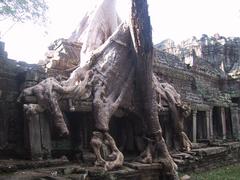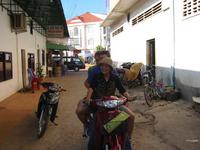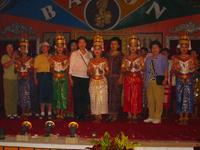Bangkok to Saigon Cycle Challenge 2003
The Temples of Angkor Wat at Siem Riep
The temple ruins of Angkor Wat were clearly a high point of the
trip. Angkor Wat is actually just one of many temples in the area to the
North of Siem Riep, although it is the biggest and most
spectacular. Many temples are still hidden away in the jungle.
From our base in Siem Riep we visit the temple area by car and
accompanied by our guide. First stop is Angkor Thom, which was built as
the capital of the Khmer empire, which dominated SE Asia at the time
(~12th century). The city had an incredible one million inhabitants
living inside the 3x3 km2 city wall, this must have been the
most populous city in the world by a fair margin.
The city is entered through gates, which are flanked with massive head
sculptures. The central temple, Bayon, has extremely well preserved
bas-relief on the walls on ground to first floor levels, as well as a
huge number of face-sculptures peering down from the many towers.
 When we visit the most famous of all the temples, Angkor Wat (Wat = temple), we
were astounded by the sheer size of the structure.
When we visit the most famous of all the temples, Angkor Wat (Wat = temple), we
were astounded by the sheer size of the structure.
 We climbed up to (almost) the top along the outside building blocks, very
similar to a pyramid. The full hight and
steepness was simply awesome particularly as we started our descent :-)
We climbed up to (almost) the top along the outside building blocks, very
similar to a pyramid. The full hight and
steepness was simply awesome particularly as we started our descent :-)
Angkor Wat is surrounded by a moat and two sets of walls, with
smaller buildings, including several libraries, in between. Some are
visible in the picture on the right, taken
at dusk.
We didn't take too many pictures of temples, as we wouldn't have done
them justice anyway. Instead we bought a nice book with beautiful
photographs as well as explanatory text including a lot of history by
a Japanese author. The price of U$10.- (a fraction of what was printed
on the back cover) made the little girl selling it very
happy, she ran off jumping in the air and couldn't believe her luck. We
understood why when we were offered the same book at a different corner
of the temple area for half of what we had paid...
Speaking of peddlers: whenever we leave the car we are immediately
assaulted by hordes of kids selling postcards, T-shirts, musical
instruments, and all sort of junk, often quite aggressively. However,
they fall behind as soon as we enter the site proper -- tourist police
seems to run a tight ship.
 The most delicate and extraordinarily well preserved carvings are seen in one
of the smaller temples, Banteay Srei, a bit away from the Angkor site. While
attempts are made to salvage and maintain as many of the building structures
from further decay and overgrowth from the jungle forest around this area,
Ta Prohm is a temple structure
that is deliberately left to the natural forces, showing us visitors to what
extent flora takes over man-made construction—producing an almost
seamless blend.
The most delicate and extraordinarily well preserved carvings are seen in one
of the smaller temples, Banteay Srei, a bit away from the Angkor site. While
attempts are made to salvage and maintain as many of the building structures
from further decay and overgrowth from the jungle forest around this area,
Ta Prohm is a temple structure
that is deliberately left to the natural forces, showing us visitors to what
extent flora takes over man-made construction—producing an almost
seamless blend.
Near the temples there are lots of places to eat, not much different
from the many little eating places along the roads in Cambodia. There is
also a French-run, upmarket restaurant with excellent food and
impeccable service. It is part of a strategy to build up local
hospitality know-how, similar to the French-run College of
Tourism&Hospitality we have seen on the way into Siem Riep.
 Generally, the French presence is much felt through several
archaeological projects, but also through sponsorships of the likes of
the School for Silk Manufacturing or the School for Stone
Carving&Handicraft. (We had passed a stone carving workshop on the road from
Sisophon.) In terms of archaeological projects, just about every major
country has a site sponsored, including Japan and China. Interestingly,
the US engagement seems to be about the size of Switzerland's. In the
light of the destruction by US bombs during the Vietnam war, one might
have expected a bit more.
Generally, the French presence is much felt through several
archaeological projects, but also through sponsorships of the likes of
the School for Silk Manufacturing or the School for Stone
Carving&Handicraft. (We had passed a stone carving workshop on the road from
Sisophon.) In terms of archaeological projects, just about every major
country has a site sponsored, including Japan and China. Interestingly,
the US engagement seems to be about the size of Switzerland's. In the
light of the destruction by US bombs during the Vietnam war, one might
have expected a bit more.
The area is a general centre of international aid agencies. Other
evidence beyond above-mentioned French schools are: a UNESCO-sponsored
children's hospital, stores selling handicraft made by disabled people
and several massage places completely operated by blind people
(Thai-style massage -- we went each day!)
We are greatly impressed by the Silk School, a project that was
originally sponsored by the French, then supported by the European Union
and is now self-reliant. Each year, they take over a hundred poorly
educated, young people from some nearby village and train them in the
complete process of silk manufacturing, from husbanding mulberry trees
and hatching silk worms to making the silk threads, de-gumming, dying,
weaving, maintaining the equipment -- the lot. After a year, they send
the group back to their village, armed with some basic raw material and
low-tech equipment, and let them start their full production line in
that one village. Then, the school takes the next group from another
village. There is a nice shop which is an important source of the
school's income. They sell beautiful silk products (at prices that must
seem astronomical for the locals but are in fact a fraction of what you
would pay in the West).
 Siem Riep is a provincial capital, but it is immediately evident that it
is the tourism capital of Cambodia. On the way into town we ride past
hotel after hotel, some obviously very posh, others more of the backpacker
style including the one we are staying. Our little "bed&breakfast" hotel
has no restaurant attached, where they could serve a breakfast. Instead,
we are taken by one of the ubiquitous motorbikes to a nearby restaurant
(which would have only been a 5 mins walk) and back, both of us on the
double passenger seat, of course. For the ride back our driver is an elegantly dressed lady -- in Gernot's
eyes the most elegant taxi driver he has seen to date!
Siem Riep is a provincial capital, but it is immediately evident that it
is the tourism capital of Cambodia. On the way into town we ride past
hotel after hotel, some obviously very posh, others more of the backpacker
style including the one we are staying. Our little "bed&breakfast" hotel
has no restaurant attached, where they could serve a breakfast. Instead,
we are taken by one of the ubiquitous motorbikes to a nearby restaurant
(which would have only been a 5 mins walk) and back, both of us on the
double passenger seat, of course. For the ride back our driver is an elegantly dressed lady -- in Gernot's
eyes the most elegant taxi driver he has seen to date!
During breakfast, we observe a Buddhist monk show up at the entrance,
waiting patiently until one of the staff appears, takes her shoes off,
kneels in front of him and hands over some gift; then she receives a
blessing. Later, she also puts a plate with food and drink in front of
the house altar and burns some incense.
 Most restaurants are clearly only catering for tourists. This includes the one
where we are taken to on our last night in Siem Riep. After a superb buffet of
Asian delicacies there is a traditional
dance performance to live music. Actually quite good, Gernot reckons
the best value tourist trap he has seen in a long time.
Most restaurants are clearly only catering for tourists. This includes the one
where we are taken to on our last night in Siem Riep. After a superb buffet of
Asian delicacies there is a traditional
dance performance to live music. Actually quite good, Gernot reckons
the best value tourist trap he has seen in a long time.
An overall impression of Siem Reap is that the town is crawling with
(comparatively) rich Western tourists, who seem to consider the locals
mostly a nuisance, and local beggars and peddlers, who seem to see the
tourists as walking dollar signs. We go for a drink around the corner of
our hotel and find that it is full of hookers. Any single white male
entering is approached within seconds by one of the girls. Together with
all the children peddling cheap tourist items, and the very aggressive
begging, it is quite off-putting. While the temple ruins were a high
point, the town of Siem Riep was the lowpoint of the trip.
Return to main page of
Bangkok to Saigon Cycle Challenge 2003
© Gernot Heiser 2003.
 When we visit the most famous of all the temples, Angkor Wat (Wat = temple), we
were astounded by the sheer size of the structure.
When we visit the most famous of all the temples, Angkor Wat (Wat = temple), we
were astounded by the sheer size of the structure.
 We climbed up to (almost) the top along the outside building blocks, very
similar to a pyramid. The full hight and
steepness was simply awesome particularly as we started our descent :-)
We climbed up to (almost) the top along the outside building blocks, very
similar to a pyramid. The full hight and
steepness was simply awesome particularly as we started our descent :-)


